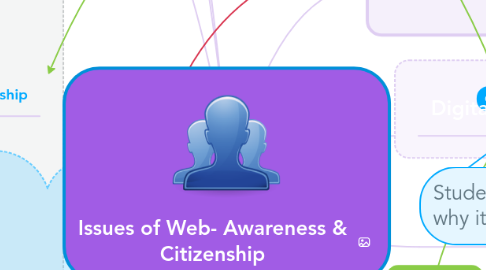
1. 9 Elements of Digital Citizenship
1.1. 1) Access
1.1.1. Who has access to my personal information and conversations?
1.1.2. What kinds of websites are students accessing at school and outside of school? What content is available on them ? What types of content are students interested in accessing?
1.2. 2) Commerce
1.2.1. How to protect banking information? What websites should have my credit card information? How reliable and trust worthy is pay pal ?
1.3. 3)Communication
1.3.1. Who is safe to talk to an share ideas with? What are the most effective ways of sharing ideas and creations with others? Blogs? Email? Text messages ? Imessage? Face time? Snap chat? Google docs?
1.3.2. What ideas and conversations are acceptable to share online?
2. 9 Elements of Digital Citizenshipship
2.1. 4) Literacy
2.1.1. Terminology development and comprehension
2.2. 5) Etiquette
2.2.1. Rules everyone should learn and become familiar with . Having this element present in more daily conversations is necessary to ensure people take this seriously and realize rules are set to protect users and help with community building.
2.3. 6) Law
2.3.1. Understanding of potential consequences and repercussions
2.4. 7) Rights & Responsibilities
2.4.1. Being a digital citizen that is productive and who is respectful of other users and their intellectual property.
2.5. 8) Health & Wellness
2.5.1. Being self aware of dependability regarding technology . Understanding that some limitations or issues when using technology on the human body can include immobility, neck strains etc.
2.6. 9) Security (self protection)
2.6.1. Fire walls, passwords , selective sharing of social media content (settings/ restrictions),
3. Using multiple search engines for research
3.1. Search terms
3.1.1. Boolean words (and/ or)
3.1.1.1. How to limit/ specify search results
3.2. Ability to be critical of online material found
3.3. How to cite material
3.4. permalinks
3.5. Where to find search engines
3.6. Authenticity
4. Marketing
4.1. Hidden user fees for websites
4.1.1. Online shopping sites
5. Practice and Exposure
5.1. Social media platforms
5.2. Websites
5.3. Typing skills
5.4. With multiple technological devices
5.5. Safety of individuals and how to care for the devices to ensure they are not ruined (awareness of cost of devices)
5.6. Developing confidence and comfort while using technology
5.6.1. Exploring sites
5.6.2. Discovering different limitations of devices and sites that users need to be aware of
5.6.3. ad blocks
5.6.4. Bookmarking / saving documents
5.6.5. Understanding of the depth of knowledge that exists and that is available to those who have basic search engine skills
6. Students must be taught what this means and why it is important that everyone is aware of.
7. Digital Citizenship
7.1. 1st step in being literate didgitaly
7.2. RESPECT all involved online
7.3. Ethics (guide)
8. Web- awareness
8.1. Bullying
8.1.1. What social media platforms can be used to do this (verbally/ written or with video or imagery) .
8.2. Sexual content exposure
8.2.1. Unhealthy sites that affect how youth understands what relationships with others may look like/ what behavior takes place.
8.3. Teacher and parent knowledge of whats students come across on the web (what they have control over and what they may accidentally come across)
8.3.1. Monitoring facebook, instagram , snaphat content . Making themselves familiar with what their child is thinking is acceptable content to share with others. Making themselves familiar with how is is used.
